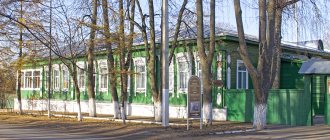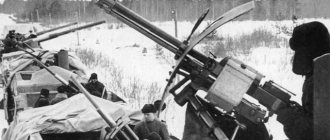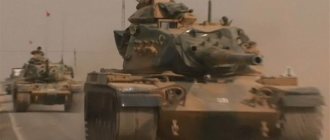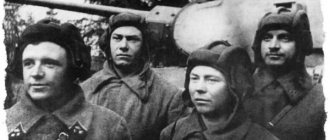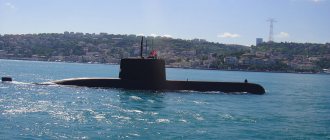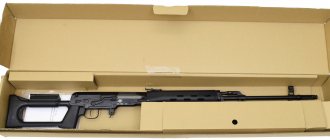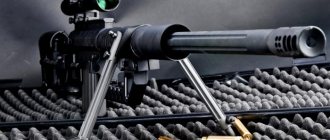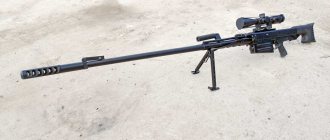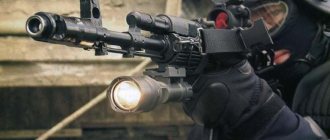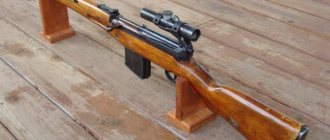Evgeniy Fedorovich Dragunov is a hereditary gunsmith who became a designer.
He created samples of precision shooting rifles, both for combat and for participation in competitions.
Dragunov weapon models are still the best among sniper rifles.
Evgeny Fedorovich was remembered as a non-conflict person with a high sense of duty.
Today's specialist designers consider Dragunov a mentor and teacher. During his lifetime, the famous designer received the Lenin and State Prizes of the Russian Federation.
↑ Biography
The date and place of birth of Dragunov is February, 1920, Izhevsk armory. Father, grandfather and great-grandfather are hereditary gunsmiths. At the time of his son’s birth, dad served in the party committee, and mom was a teacher. Zhenya learned to read and count early, and entered school 2 years earlier than his peers.
1934 – after finishing the seven-year school, he enters an industrial technical school. Here the young man independently becomes acquainted with automatic weapons from books written by Fedorov. An excellent shooter since childhood, Zhenya takes part in bullet shooting competitions and becomes a “Voroshilov Marksman of the 2nd degree.” After finishing his studies, the young man gets a job at a weapons factory as a technician, processing metal.
1939 - leaves to serve in the Far East in the artillery corps. After 2 months, Dragunov was sent to the school for junior commanders for 2 years. After receiving the title - a new direction, already to the School of Weapons Masters.
- During the Second World War he was a senior gunsmith.
- 1945 - return to his home plant in Izhevsk to the position of senior weapons master in the main design bureau.
- 40-50s - works on improving the Mosin rifle and developing sports weapons.
- 1958 - a semi-automatic sniper rifle is next in line.
- 1963 - the new rifle was approved as a standard weapon for combat snipers.
The Afghan military operations required the construction of a compact SVD. Evgeniy Fedorovich did not have time to complete the work; on August 4, 1991 he passed away. The project was completed by Azary Ivanovich Nesterov and his team.
Evgeny Fedorovich Dragunov
Evgeniy Fedorovich Dragunov was born on February 20, 1920 in Izhevsk, in a family of hereditary gunsmiths. His grandfather also worked at the Izhevsk plant as a foreman. According to family tradition, Evgeniy graduated from the Izhevsk Industrial College and became a metal cutting technician at the same arms factory. He dedicated his first project to the technology of refining the bayonet for the Mosin rifle. In 1939 he was drafted into the Army to serve in the regimental repair shop. During the war years he was promoted to the rank of senior gunsmith. After the war, he returned to the plant, to the Chief Designer Department; the plant needed the experience and knowledge of a young designer. To improve the level of knowledge, I went to study at the correspondence department of the institute. The first post-war work was to improve the reloading mechanism of the Mosin M1891/30 sniper rifle. In battles, the rifle showed itself to be very reliable, with accurate firing, but reloading it was not entirely convenient; cartridges were inserted into the magazine one at a time - the low-set sight was in the way. Dragunov solved this problem by developing a bracket of a new design that allowed reloading to be done immediately with a clip. In the late 40s and early 50s, based on the Mosin M1891/30 rifle, Dragunov developed a range of Soviet high-precision sporting rifles. With his direct participation, 27 samples were created: MTs-50, MTsV-50, Zenit, Strela, Taiga, SM, Biathlon-7-2 and others. In 1958, Dragunov was entrusted with the development of a new semi-automatic sniper rifle. Soviet military science formulated the concept of combat tactics of sniper warfare: mobile, with multiple targets, where accurate and high-speed targeted fire is required. In addition to high accuracy, the rifle must have a light, compact configuration, capable of conducting semi-automatic fire in any combat and climatic conditions: from a shelter, from the cockpit of a land and water vehicle, from a helicopter, in heat and cold, in dry land and pouring rain. It was necessary to spend one cartridge on one target. Then, in 1958, Dragunov created the first model, called SSV-58. In a stubborn struggle with such master gunsmiths as M. Kalashnikov, A. Konstantinov and F. Barinov, the competition was won by Dragunov and in 1963 the SVD became the standard weapon of army snipers. By creating the SVD, Evgeny Fedorovich Dragunov created a powerful base for the development of Russian sniper rifles. On the basis of the SVD the following were created: SVDS, SVU, SVU-A, and the Tiger hunting carbine. The sons of Evgeny Fedorovich Dragunov, Mikhail and Alexey Dragunov, are also gunsmith designers. Evgeniy Fedorovich died on August 4, 1991.
02 August 2013
↑ Designer Dragunov
Dragunov, working in a weapons workshop during the war, had access to both Soviet and captured weapons. I studied the design, made comparisons, tried to modify it. Having resumed work at the factory in 1945, he had extensive experience in studying rifle samples. Therefore, after 1 year, having received the first task, the chief design bureau did it perfectly.
The young gunsmith was entrusted with the design of the PU bracket on a multi-shot sniper rifle. Having earned the favor of the managers, Evgeniy Fedorovich becomes a design engineer. After some time, he became a leading engineer. Dragunov is assigned to work with a sports rifle. Since that time, the experienced designer has been designing high-precision sporting weapons and continues to improve the Mosin rifle.
Nikolay Starikov
Source: https://weaponland.ru/ Evgeniy Fedorovich Dragunov occupies a special place among domestic small arms designers; he devoted his entire life to creating first-class precision weapons. And today, forty years after being put into service, his SVD rifle and its modifications, in terms of their technical characteristics and combat properties, remain a modern model, superior to many sniper rifles.
Evgeny Dragunov was born on February 20, 1920 in Izhevsk into a family of hereditary gunsmiths. His grandfather also worked at the Izhevsk arms factory. It was in the family that Genet was instilled with a love of firearms. Already at the age of fourteen he showed excellent results in shooting, and in 1934 he was awarded the “Voroshilov Shooter” badge, 2nd degree. In the same year, after finishing the seven-year school, Evgeniy went to study at the Izhevsk Industrial College, where his first acquaintance with automatic weapons took place when he read the books of the luminary of the domestic arms business V. Fedorov. “Fyodorov’s books were my first textbooks in the field of weaponry,” Dragunov later recalled. In 1939, Evgeniy was drafted into the Red Army and sent to the school for junior commanders, and later to the school of weapons mastery. During the Great Patriotic War, senior gunsmith Dragunov, who served in the Far East, did not go to the front. Specialists of this level were also needed in the rear. Hundreds of a wide variety of small arms, including captured ones, passed through the skillful hands of Dragunov, who worked in the weapons workshop.
AVL sporting rifle
In 1945, Dragunov returned to the Izhevsk Machine-Building Plant, where he again continued to work as a senior gunsmith in the chief designer's department. The young gunsmith coped with one of the first tasks entrusted to him by the chief designer of the plant “excellently.” Dragunov designed a new bracket for a PU optical sight for a sniper rifle mod. 1891/30, which allowed the rifle to be loaded not with one cartridge at a time, as was the standard model, but with five cartridges from the clip at once. Dragunov's first success, due to his deep knowledge of weapons and the intuition of an inventor, immediately endeared him to the management of the OGK plant. Soon he was transferred to the position of design engineer, and then leading engineer. The promising designer is entrusted with a more complex task - to develop a new sports rifle for target shooting. This opened the next stage in the life of Evgeniy Fedorovich. Since the late forties, he began to design various types of high-precision sporting rifles, continuing to improve the Mosin system rifle. Already in 1949, Dragunov created on the basis of a rifle model 1891/30. his first target rifle, the S-49. The following year, Soviet shooters with Dragunov weapons set a world record at international shooting competitions in Sofia. In the fifties, Dragunov developed a whole range of sports rifles for free shooting, including: TsV-50, MTsV-50, TsV-55 “Zenith”, “Strela”, “Taiga”, many of which repeatedly helped Soviet sports shooters achieve victories at international competitions. Under his leadership, standard sporting rifles and “Running Deer” rifles began to be developed in Izhevsk. For the implementation of his innovative proposals, Dragunov received seven copyright certificates for inventions.
Sniper with SVD rifle
The next stage in Dragunov’s life was the creation of a sniper rifle. At the end of the fifties, Evgeniy Fedorovich was one of the first to be offered to participate in a new competition to create a self-loading sniper rifle. In 1959, Dragunov presented the first version of his SV-58 sniper rifle for testing.
The designer later recalled: “When work began on creating a sniper rifle in 1958, we already had a wealth of experience in fine-tuning and manufacturing high-class combat samples, but there was almost no experience in debugging such samples. We only knew one thing: ABC arr. 1936 and SVT arr. 1940 did not meet the new requirements even halfway. The main difficulties that confronted us during the design were the need to overcome various contradictions. Suffice it to say that for reliable operation in difficult conditions, you need to have the largest possible gaps between the moving parts, and in order to have better accuracy, you need to fit everything as tightly as possible. Or the weight is required to be very light, and for better accuracy, the heavier it is to a certain limit, the better. And a whole series of large and small contradictions. In general, we approached the finale already in 1962, having experienced a whole series of failures and successes. Suffice it to say that we have been working on the store for over a year. The forend assembly, although seemingly simple, turned out to be the most difficult, and we finalized it at the very end. In this work, my passion for shooting sports, which I have been involved in for almost 20 years, has come in handy more than ever. Five years of experience as a gunsmith in the army gave me a wealth of material on the operation of weapons, and this also helped to some extent in the design work.”
SVD sniper rifle with optical sight PSO-1
During testing, the Dragunov rifle showed good combat accuracy, but caused a significant number of delays and even breakdowns of some parts on average every 500-600 shots. The next year and a half was spent refining the design and achieving the required reliability of all mechanisms. By April 1960, state tests of the sniper rifles submitted for the competition were completed. None of the presented samples fully satisfied the requirements of the tactical and technical specifications. The Dragunov rifle, in terms of the degree of compliance with the TTT, occupied an intermediate place between the Konstantinov and Simonov rifles. The insufficiently reliable operation of the Dragunov rifle was explained by a design flaw in the magazine and mainspring. A serious drawback of this rifle was that its trigger mechanism did not ensure safe handling of the weapon.
SVD sniper rifle with night optical sight 1PN51
At the end of 1961, Simonov had to remove his sample from testing due to insufficient combat accuracy. In the uncompromising struggle that unfolded between the designs of Konstantinov and Dragunov, the Izhevsk rifle won a well-deserved victory. The SVD was recommended for production as it most fully satisfies the tactical and technical requirements for combat and operational characteristics.
The Dragunov self-loading sniper rifle was adopted by the Soviet army in 1963. The SVD became the pinnacle of Dragunov’s design activity and was a great creative success for the talented inventor, the result of his hard work. As part of the group of creators of Soviet small arms in 1964, Evgeniy Fedorovich was awarded the Lenin Prize.
Internal troops sniper with an SVD rifle. January 1995, Grozny
The excellent combat and operational qualities of the Dragunov sniper rifle were objectively assessed not only by Soviet, but also by foreign military experts. So, in 1989, an article devoted to this weapon was published in the Swiss military magazine “Schweizer Waffen-Magazin”. It said: “In the West, the Soviet Dragunov sniper rifle chambered for the classic Russian military cartridge with a 7.62x54 rim is considered a rare item among collectors. We put one of them to practical testing... The Dragunov sniper rifle is very well designed. Contrary to the traditional canons of designing precision weapons, the former sports shooter Dragunov made his rifle a light weapon. With an optical sight and a full magazine, it weighs 4.55 kg. The forend, consisting of two halves, equipped with a large number of longitudinal slots that serve for cooling, as well as the butt of the frame structure with an integrated pistol grip, are made of plywood board. The center of gravity of a loaded rifle is located almost exactly at the level of the magazine. NATO regulations require sniper rifles to have a maximum dispersion radius of 600 yards (548.6 m) for a 10-shot burst of 15 inches (38.1 cm). The Soviet Dragunov sniper rifle confidently meets these requirements. Recoil, despite the relatively powerful cartridges, is moderate. Dragunov rifles are known for being able to function reliably in the most difficult conditions without extensive maintenance.”
In the sixties, Dragunov worked on introducing his rifle into mass production, solving problems to improve the quality of its manufacture, reduce labor intensity and reduce the cost of production.
In the late 1960s - early 1970s. a group of designers led by Dragunov was developing an automatic sniper rifle based on the standard SVD. The designers tried to combine the best properties of a sniper rifle in one model, while at the same time increasing the effective firing range when conducting continuous fire. The new model of Izhevsk weapons received the index B-70. Compared to the SVD, the Dragunov automatic rifle has become slightly heavier (weight without cartridges and optical sight 4.6 kg). In addition, it had a weighted barrel of shorter length, the trigger mechanism allowed for single and automatic fire, and the butt had a different shape. The ability to conduct continuous fire in short bursts led to an increase in the magazine capacity to 20 rounds and the need to equip the rifle with a bipod telescopic bipod equipped with a mechanical barrel drift compensator. However, the relatively light rifle, designed for a powerful rifle cartridge, was unable to provide the required accuracy when conducting continuous fire, and the recoil impulse exceeded the permissible parameters several times. Therefore, after many years of work, this research topic was considered unpromising and closed.
SVD-S sniper rifle (with folded stock, without optical sight)
At the end of the eighties, new requirements were imposed on the sniper rifle, limiting the dimensions of the weapon. This was due to the need for optimal placement of the rifle in the fighting compartments of infantry fighting vehicles and armored personnel carriers, as well as to ensure the possibility of landing airborne snipers along with their weapons. A group of designers led by Dragunov began creating a new modification of the SVD sniper rifle with a folding stock, but due to the death of Evgeniy Fedorovich, gunsmiths under the leadership of another most experienced Izhevsk designer A. Nesterov had to complete this work. As a result of this work, two experimental versions of the SVD with a folding stock appeared: SVDS-A (army) with a barrel length of 620 mm and SVDS-D (airborne) with a barrel length of 590 mm. To reduce the overall length of the weapon, the designers developed a new shortened conical slotted flame arrester, the length of the working area of which was only 29 mm versus 78 mm in the standard SVD. The rifle received a plastic pistol grip fire control. The stock, which folded onto the right side of the receiver, was made not of plywood, but of steel pipes. The buttstock is made of glass-filled polyamide. A permanent plastic support for the shooter’s cheek was placed on the top tube of the butt. In the stowed position or when firing from an open sight, the support rotates down. The lug for attaching the bayonet was removed from the barrel. As a result of the tests, it was decided to keep only the “landing” model of the rifle, which was adopted by the Russian Armed Forces in 1992 under the designation SVD-S (with a folding stock). The total length of the new weapon was 1135 mm with a barrel length of 565 mm. The weight of the SVD-S rifle with an empty magazine and without an optical sight is 4.5 kg.
SVD-S sniper rifle with night optical sight 1PN51
In the nineties, the Dragunov rifle itself, due to improvements in manufacturing technology, underwent some changes: the wooden stock and fore-end pads were replaced with more durable and comfortable ones - made of glass-filled polyamide. The rifle was equipped with an adjustable telescopic bipod S-1. This weapon proved itself worthily during combat operations during the counter-terrorism operation in the Chechen Republic.
Another area of work of Evgeny Fedorovich Dragunov was the creation of automatic melee weapons - small-sized submachine guns and machine guns. In the early seventies, he designed the 9-mm PP-71 Kedr submachine gun. In addition, in 1975, Dragunov began work on a 5.45-mm small-sized assault rifle, which was intended to arm primarily grenade launchers, as well as crews and crews of technical branches of the military. The designer created two samples of this weapon, known under the designation MA (small-sized machine gun). A special feature of the Dragunov assault rifle, which consisted of two parts, was its original layout, which to some extent repeated the layout of the Sudaev PPS submachine gun. The upper part of the structure consisted of a barrel with a receiver and a movable automation system suspended on it (a bolt frame with a bolt and a return mechanism). A plastic stock with a pistol grip for fire control was attached to the front liner of the receiver on a hinge (which significantly influenced the lightening of the weapon up to 2.5 kg with an empty magazine). A trigger mechanism was mounted in the stock. To reduce the height of the receiver, a pusher was used in the design of the side-mounted gas engine, made separately from the bolt frame. In the rear part of the stock there was a metal butt folding on top of the receiver with a folding butt, which significantly reduced the dimensions of the MA (total length - 735 mm, length with the butt folded - 500 mm, barrel length - 212 mm). When folded, the butt did not overlap the sighting devices. The receiver was fixed in the stock by a return mechanism. The stock, spring-loaded forend and receiver guard are made of glass-filled polyamide AG-4V. The first MA model had a standard reinforced flame arrester from the AKS-74U. In the second model, asymmetrically located compensation slots were created in the front part of the flame arrester. They were intended to more effectively extinguish the muzzle flame and move the barrel of the machine gun to the right and upward when firing automatic fire. The cartridges were fed from a standard 30-round magazine from an AK-74 assault rifle. In terms of accuracy of fire with single and automatic fire from various positions, the MA was at the level of the Kalashnikov AKS-74U assault rifle. However, by 1978, when Dragunov finished work on his model, the USSR Ministry of Defense had already approved a decision to adopt a model of a shortened Kalashnikov assault rifle. In this regard, further work on the 5.45 mm MA assault rifle was curtailed.
Over the forty years of work of Evgeny Fedorovich Dragunov in the department of the chief designer of the Izhevsk Machine-Building Plant, he created 27 samples of small arms, of which 10 were mass-produced. Dragunov, who established the basic principles of designing high-precision combat weapons and created a first-class self-loading rifle, took one of the places of honor among the famous Soviet gunsmith designers. He was awarded the Order of the Badge of Honor and many medals.
Evgeniy Fedorovich died on July 4, 1991. The designer's services to the Motherland were fully recognized only after his death. By Decree of the President of the Russian Federation No. 657 of June 6, 1998, Dragunov was awarded the State Prize for the creation of sports and hunting weapons.
If you find an error, please select a piece of text and press Ctrl+Enter.
↑ What Dragunov came up with
Evgeniy Fedorovich became a world-famous designer for the small sporting and military weapons he created - the Degtyarev sniper rifle.
- 1950 - Soviet shooters, using the S 49 rifle, set a new world record in Bulgaria.
- 50s - a number of sporting rifles called “Zenith”, “Taiga”, “Strela” and others.
- A standard sporting rifle and a Running Deer rifle are being developed.
- In 1959, the creation of the SV 58 self-loading sniper rifle.
- 1961 - the SVD rifle wins the competition and in 1963 it is put into service in the USSR army.
- Work on automatic weapons for close combat - a small-sized pistol - a machine gun (Kedr) and machine guns.
- 1975 – two samples of a compact machine gun.
Over 40 years, Dragunov created 27 models of shooting weapons, 10 of them were produced in series.
Encyclopedia of weapons
Dragunov Evgeniy Fedorovich
The famous Russian weapons engineer, designer, creator of the SVD is Evgeniy Fedorovich Dragunov, the pride of Russian science.
This man’s whole life was connected with weapons; a hereditary gunsmith, he devoted himself to this matter and created one of the most famous sniper rifles in the world. Evgeny Dragunov was born on February 20, 1920 in Izhevsk into a family of hereditary gunsmiths. His grandfather also worked at the Izhevsk arms factory. It was in the family that Genet was instilled with a love of firearms. Already at the age of fourteen he showed excellent results in shooting, and in 1934 he was awarded the “Voroshilov Shooter” badge, 2nd degree.
In the same year, after finishing the seven-year school, Evgeniy went to study at the Izhevsk Industrial College, where his first acquaintance with automatic weapons took place when he read the books of the luminary of the domestic arms business V. Fedorov. “Fyodorov’s books were my first textbooks in the field of weaponry,” Dragunov later recalled. After graduating from college, Evgeniy went to work as a metal cutting technician at the same arms factory as his ancestors.
In 1939, E. Dragunov was drafted into the Army and sent to the school for junior commanders, and later to the school of weapons mastery. During the Great Patriotic War, senior gunsmith Dragunov, who served in the Far East, did not go to the front. Specialists of this level were also needed in the rear.
Through the skillful hands of Dragunov, who worked in the weapons workshop, hundreds of various types of small arms, including captured ones, passed through: Soviet, German, Italian, American, English - and he still noticed, invented something, tried to bring his own.
In 1945, Dragunov returned to the Izhevsk Machine-Building Plant, where he again continued to work as a senior gunsmith in the chief designer's department. The young gunsmith coped with one of the first tasks entrusted to him by the chief designer of the plant “excellently.”
Dragunov designed a new bracket for a PU optical sight for a sniper rifle mod. 1891/30, which allowed the rifle to be loaded not with one cartridge at a time, as was the standard model, but with five cartridges from the clip at once. Dragunov's first success, due to his deep knowledge of weapons and the intuition of an inventor, immediately endeared him to the management of the OGK plant.
Soon he was transferred to the position of design engineer, and then leading engineer. The promising designer is entrusted with a more complex task - to develop a new sports rifle for target shooting. This opened the next stage in the life of Evgeniy Fedorovich.
Already in 1949, Dragunov created on the basis of a rifle model 1891/30. his first target rifle, the S-49. In general, the Mosin rifle became a kind of favorite hobby for Dragunov. In the late 40s and early 50s, based on the 1891 model, Dragunov developed a whole range of sporting rifles. It would not be an exaggeration to say that Dragunov is the founder of a whole trend in the creation of Soviet high-precision rifles.
With his direct participation, 27 (!) samples were created: MTs-50, MTsV-50, Zenit, Strela, Taiga, SM, Biathlon-7-2 and others, many of which were brought to our athletes more than once gold at international competitions of the highest level. Under the leadership of Evgeniy Fedorovich, standard sporting rifles and “Running Deer” rifles are beginning to be developed in Izhevsk.
For the implementation of his innovative proposals, Dragunov received seven copyright certificates for inventions. The next stage in Dragunov’s life was the creation of a sniper rifle. At the end of the fifties, Evgeniy Fedorovich was one of the first to be offered to participate in a new competition to create a self-loading sniper rifle.
In 1959, Dragunov presented the first version of his SV-58 sniper rifle for testing. This sample is noticeably different from the SVD we are used to. The barrel linings have 3 ventilation holes, not 5. The stock does not have an adjustable cheekpiece. The barrel and muzzle device look a lot like an AK.
Actually, there is no muzzle device as such and is a sleeve similar to an AK-47. This model is distinguished by good accuracy of combat, but the overall reliability and especially the survivability of the mechanisms leave much to be desired. The next three years were spent refining the design and achieving the required reliability of all mechanisms.
In addition to Dragunov, such famous designers as A. Konstantinov and F. Barinov took part in this competition. and M.T. Kalashnikov. He developed two models that largely copied their predecessor, the AKM.
In the uncompromising struggle that unfolded between the samples, the Izhevsk rifle won a well-deserved victory. The SVD was recommended for production as it most fully satisfies the tactical and technical requirements for combat and operational characteristics.
In 1963, the SVD became the standard weapon of army snipers. Along with the SVD, Dragunov created the little-known, but very interesting in design, TSV-1 - a training sniper rifle chambered for a 5.6 mm rimfire cartridge. In many ways, it copies the SVD, and this is understandable, because its main task is to serve as a training weapon for snipers before they have the opportunity to shoot from real combat weapons.
In the sixties, Dragunov worked on introducing his rifle into mass production, solving problems to improve the quality of its manufacture, reduce labor intensity and reduce the cost of production. In the late 1960s - early 1970s. a group of designers led by Dragunov was developing an automatic sniper rifle based on the standard SVD.
The designers tried to combine the best properties of a sniper rifle in one model, while at the same time increasing the effective firing range when conducting continuous fire.
However, the relatively light rifle, designed for a powerful rifle cartridge, was unable to provide the required accuracy when conducting continuous fire, and the recoil impulse exceeded the permissible parameters several times. Therefore, after many years of work, this research topic was considered unpromising and closed.
Another area of work of Evgeny Fedorovich Dragunov was the creation of automatic melee weapons - small-sized submachine guns and machine guns. In the early seventies, he began developing the 9-mm PP-71 Kedr submachine gun.
With the outbreak of hostilities in Afghanistan, there was talk among the military that the SVD needed to be made even more compact, because the standard rifle did not fit well into the limited space of the infantry fighting vehicle. Dragunov was cautious. Experience suggested that a folding stock could negatively affect the accuracy of the battle. This required a balanced and clearly proven approach. But in connection with the death of Evgeniy Fedorovich, the gunsmiths had to complete this work under the leadership of another experienced Izhevsk designer A. Nesterov.
Over the forty years of work of Evgeny Fedorovich Dragunov in the department of the chief designer of the Izhevsk Machine-Building Plant, he created 27 samples of small arms, of which 10 were mass-produced.
Dragunov, who established the basic principles of designing high-precision combat weapons and created a first-class self-loading rifle, took one of the places of honor among the famous Soviet gunsmith designers. He is a laureate of the Lenin Prize, awarded the Order of the Badge of Honor, as well as many medals.
He was an unusually open person, always surrounded by friends, colleagues, and students. Evgeniy Fedorovich loved to go hunting and was an excellent shooter. He raised two sons - Mikhail and Alexei. Mikhail Evgenievich Dragunov completed the work begun by his father on the creation of the Kedr industrial enterprise.
The youngest son, Alexey Evgenievich, followed in his father’s footsteps. It was he, in collaboration with Viktor Timofeevich Kalashnikov, who created the Bison submachine gun at Izhmash, so the Dragunov dynasty is alive, and now his grandson is learning weapons theory at IzhSTU.
Evgeniy Fedorovich died on July 4, 1991. The designer's services to the Motherland were fully recognized only after his death. By Decree of the President of the Russian Federation No. 657 of June 6, 1998, Dragunov was awarded the State Prize for the creation of sports and hunting weapons.
And one more thing, it was the SVD that became, in a different way, the “conversion” basis for the creation of hunting weapons. Almost in parallel with the sniper rifle, the production of the “Bear” hunting carbine began in Izhevsk (for several years it was even produced in secret), structurally, in an advanced manner, identical to the SVD, and then this “family” was replenished with other “Bears”, “Tigers”, “Wapit” .
And to this day, every connoisseur and connoisseur of hunting weapons dreams of having them in his collection; it is no coincidence that these particular carbines were presented as a particularly valuable gift to the leaders of many countries. The Dragunov cause lives and wins!
‹ John Thompson Up Johann Dreyse ›
↑ Personal life and children
Evgeniy Fedorovich has a large family - two sons and two daughters. His wife, Lydia Nikolaevna, was helped by her grandmother to raise the children. They lived together in an apartment given to Dragunov for his services. After finishing their studies, both sons continued their father’s work, working with him in the same design bureau.
Grandsons, Evgeny and Alexey, also became gunsmiths. The eldest son Mikhail is an associate professor, and was finalizing the pistol - the Kedr submachine gun. Author of six inventions, 20 scientific papers and publications related to the history of Soviet weapons and the developments of the Izhevsk mech. plant Knows German and English.
MAKSIMOV.SU
The name of Evgeniy Fedorovich Dragunov is familiar to the whole world thanks to the SVD rifle mod. 1963.
Its development began in 1958, but 10 years before that, a then little-known designer was creating modernized versions of the rifle mod. 1891/30
Based on the "mosinka"
Evgeniy Fedorovich designed a whole range of sniper and sporting rifles. Unfortunately, practically nothing is known about them; there simply have not been any detailed publications. This is especially true for the earliest, first samples.
7.62 mm sniper mod. 1948
Of course, SVD alone
it was enough to perpetuate the memory of Yevgeny Fedorovich and the appearance of another milestone in the history of weapons, a milestone no less significant than the symbol of the era - the AK. But now, in the context of the rapid development of communications and free access to previously “closed” information, it is rare and forgotten old systems that are of increasing interest.
Especially those created by famous gunsmith designers. This article is intended as the first material in a series about E.M. rifles. Dragunov, which are based on the Russian “three-line” bolt group.
photo from 1940,
Dragunov after graduating from AIR (artillery instrumental reconnaissance) school. On the tunic there is a “Voroshilov shooter” badge. We were proud of this sign
Book of the Red Army soldier Dragunov
MS-74
From the memoirs of E.F.
Dragunova Thanks to M.E. Dragunov,
who once recorded and preserved the memories of Evgeniy Fedorovich, it became possible for the first time to publish the unique history of the creation of the first Dragunov sniper rifle.
…"In 1948
I was tasked with modernizing a sniper rifle model 1891/30. The requirements for the rifle were mainly in terms of accuracy and ease of loading. It was necessary to load the rifle from a clip, and not to equip the magazines with one cartridge at a time, as in the rifle in service with a “PU” sight on a bracket of the 1942 model.
The standard rifle weighed up to 5.1 kg.
The Kochetov bracket of the 1942 model was very heavy, weighing about 0.6 kg together with the base. The position when shooting with optics was inconvenient. You had to lift your head high and hold your cheek up. When observing the battlefield for a long time through the sight, the neck muscles became very tired, which reduced the effectiveness of shooting. All this was well known to me, as a sports shooter.
sniper rifle mod.
1891/30 with a PU sight on a Kochetov bracket mod. 1942
Upgraded rifle
under (modernized sniper, factory No. 74) had high accuracy.
The first three rifles showed an accuracy of R100 of the order of 4 - 5 cm and R50 of the order of 1.5 - 2.0 cm. (R100 is the radius of the circle containing 100% of all hits; R50 is the radius of the circle containing 50% of the hits closest to the center of dispersion ). IZHMASH Museum
They have
there was a pistol stock, a trigger with a “warning”.
The rifle barrel was made more massive, more than 0.5 kg heavier than the standard one, and the rifles themselves became 100 grams lighter due to a lighter sight mount (weight with the base about 230 g) and lighter weight of some parts. The rifle successfully passed field tests,
showing an advantage over its competitor - the rifle of Simonov S.G., and was recommended for implementation.
At the customer’s request, we sent documentation for it, and that was the end of the matter. 7.62 mm sniper
The latest rifles mod. 1891/30
and Model 1944 carbines were made in 1948. And in 1949, the plant began to develop the AK-47. Until April 1949, I was engaged in solving various design issues on other products" (including in the development of the Kalashnikov assault rifle; E.F. Dragunov analyzed the operation of the trigger mechanism, during which he found and eliminated the reason for the trigger "tracking" of the bolt frame)".
rifle E.F.
Dragunov MS-74 mod. 1948
Museum of the History of IZHMASH
Museum
is located in one of the most picturesque historical corners of Izhevsk and is located in the oldest building in the city - the former “Money Pantry”, built in 1804. The museum, undoubtedly one of the best in the world, contains a unique collection of basic samples of firearms and bladed weapons, created by Izhevsk gunsmiths over more than 200 years.
Without exaggeration
we can say that from the museum’s exhibitions one can trace the evolution of Russian small arms produced in Izhevsk - combat, sporting and hunting.
IZHMASH Museum
Last 4 years
The director and chief custodian of the museum's funds is Alexey Alekseevich Azovsky. And before him, Viktor Petrovich Ionov, who worked as director of IZHMASH in the 1970s, worked in this post for 10 years.
Director of the IZHMASH Museum Azovsky Alexey Alekseevich
Actually, in the museum's funds
history of Izhevsk Machine-Building and there are samples of the entire (or almost the entire) line of weapons created by E.F. Dragunov over 40 years of work. The museum itself, in addition to being located in a suitable building, has a superbly constructed exhibition line, richly and professionally filled with rare exhibits.
Only one thing is depressing
– already in our time, the barbarously carried out by the Ministry of Internal Affairs “decontamination” of all available weapons, the rarity of individual samples of which can only evoke the admiration of connoisseurs.
IZHMASH Museum
MS-74
in our hands
Mikhail Evgenievich
For the first time in his life, he picks up the MS-74 rifle, developed by his father 65 years ago. I must say that the son of the creator of SVD is a very modest person in life, and this is not just my opinion.
His,
like many representatives of the “old” Izhevsk weapons school, one can be classified as one of the very technical intelligentsia, which is an undoubted example for the younger generations of Russian gunsmiths, and indeed for any normal person.
Mikhail Dragunov
has a classical education as a gunsmith-designer, has encyclopedic knowledge, is an experienced teacher, has an excellent command of technical English, but at the same time, he still only draws on a drawing board.
Communication
meeting with Mikhail Evgenievich and his younger brother Alexei is interesting in itself, not to mention the value of the information received about the history of domestic weapons.
M.E.
Dragunov with his father's rifle
Performance characteristics of the MS-74 rifle
•The serial number of the weapon is No. 6.
•Weight of the rifle with PU optical sight and bracket – 4.84 kg
•Weight of PU sight with bracket – 0.40 kg
•Bracket weight – 0.13 kg
•Barrel length (to the front end of the receiver) – 706 mm
•Barrel diameter at the muzzle – 17.7 mm
•Barrel diameter at the breech – 30 mm
•Distance from the trigger to the middle of the back of the butt – 337 mm
•Position of the rifle’s center of gravity relative to the front end of the receiver:
a)With an optical sight installed – about 35 mm forward
b) Without a sight - about 45 mm forward
7.62 mm sniper 1948
At first sight,
the rifle resembles an ordinary “three-ruler”, the only differences are in the pistol neck of the butt and in the long forend without the lower stock ring. Then, upon closer inspection, you pay attention to the changed shape of the barrel lining, the ramrod hidden in the stock, a more compact sector sight, a different shape of the breech of the barrel and the unusual design of the vertical base bracket of the PU sight.
7.62 mm sniper 1948, optical sight bracket
Certainly,
It was the changes in the design of the barrel, the sight mount and the ergonomics of the stock that aroused the greatest interest. The most superficial examination clearly confirms that based on the bolt group of the rifle mod. 1891/30 Evgeniy Fedorovich created an almost new model of “sniper rifle”, in modern English slang - “custom”.
7.62 mm sniper 1948, muzzle
During the manufacture of MS-74
it was necessary to make a new barrel, a sight bracket with a base, and also a new stock. With all the desire for unification with the usual “mosinka”, only the receiver, the bolt (not counting the handle), the magazine, the front sight with the base and part of the stock device remained unchanged.
7.62 mm sniper 1948
Rifle barrel
It has a conical configuration, without a sharp bottle transition, and is as heavy as possible, as far as technical specifications allowed (a sports barrel of a similar contour is now used on the KO-91/30M in development and production and has shown itself to be the best).
7.62 mm sniper mod. 1948
Compact sector sight
similar to the “mechanics” from carbines mod. 1938 and 1944, “cut” to a very reasonable 1000 meters. The front part of the sight serves as a retainer for the rear part of the receiver lining, the front end of which is secured with a conventional spring-loaded stock ring.
7.62 mm sniper 1948, open sight
On the breech of the barrel
The following marks are engraved with a serviche: a hammer and sickle surrounded by ears of grain, a factory “triangle”, model name – “MS-74”, serial number – “No. 6” and year of manufacture – “1949”
7.62 mm sniper 1948, barrel branding
Sight bracket,
together with the base, it is designed almost from scratch and, if necessary, can be removed from the rifle in just a couple of seconds.
Evgeniy Fedorovich in his memoirs mentions the need to reduce the weight of the bracket and preserve the possibility of clip-on loading of the rifle. 7.62 mm sniper 1948, bracket
Bracket base
Dragunov resembles the base diagram of the bracket mod. 1942, while, as can be clearly seen in the photographs, Evgeniy Fedorovich’s design is much lower, more elegant and lighter.
There were no excessively powerful mounting screws
(and also without locking screws), but the same powerful pins are left, the front ball joint of the bracket is retained, but it is made adjustable along the longitudinal axis.
And here
When installed, the rear part of the bracket “sits” on top of the hook and is fixed on it according to the same principle as an AK or SKS gas tube - with a rotary eccentric driven by a small spring-loaded lever.
Bottom of bracket
was sawed off during rough vertical alignment, and, in turn, had the possibility of a finer adjustment using screws.
7.62 mm sniper 1948, bracket
On Kochetov's bracket
The sight tube is fixed using powerful spring-loaded all-milled rings, while the rings are tightened with three screws (2+1) in the “top” direction. On the MC-74, the bracket rings are narrower and much more elegant, they are tightened in the “sideways” direction, while one screw was enough per ring.
7.62 mm sniper 1948, PU sight mount design
Charging capability
rifle from the clip resulted in a strong shift of the optical sight axis to the left. Once upon a time, such a shifted position was the norm, but, to be honest, for me personally, aiming from the MS-74 caused noticeable discomfort. On the SVD, the PSO-1 sight is also noticeably shifted to the left, but not so much.
7.62 mm sniper 1948, bracket and its base for mounting an optical sight
Wherein
on the butt of the SVD there is a convenient cheek that “deflects” the aiming eye from the axis of the weapon to the desired value. The MC-74 model does not have a cheek and, for normal aiming, some getting used to is required.
7.62 mm sniper 1948, PU sight mount design
Interestingly,
There are similar brackets on several modifications of the three-ruler (also located in the IZHMASH weapons museum), designed specifically for hunters after the war.
Disassembling the rifle
did not bring any difficulties - the ramrod is held in place by friction, the stock ring is removed as on a regular rifle mod. 1891/30, after which the receiver lining is removed by moving forward and upward, and the coupling screws of the receiver and magazine are unscrewed.
7.62 mm sniper 1948, front part of the forend, removing the ring
7.62 mm sniper 1948, dismantling the receiver lining
Admit,
I assumed that the MS-74 would have some kind of modernization of the trigger (at least in terms of the trigger force, as on the pre-war 8.2 mm Kochetov hunting carbine), but the trigger mechanism of the first “Dragunov” sniper turned out to be the most ordinary.
7.62 mm sniper 1948, incomplete disassembly
Wherein
The kinematic chain “trigger-sear-hammer” still felt fine-tuned to certain values, the force and nature of the trigger can be called quite acceptable for accurate shooting (especially taking into account the then requirements for military weapons, even sniper ones).
7.62 mm sniper 1948, lower receiver and trigger
On the bottom of the shank
The receiver is stamped with the factory mark and the year of production of the box - 1948. What is interesting is that it is 1948 that is stamped on most of the post-war "frolovkas" of post-war production.
7.62 mm sniper 1948, stamp on the receiver shank
rifle stock
definitely comfortable, although somewhat unusual. Pay attention to the pronounced “pistol” of the buttstock handle. Even then, Evgeniy Fedorovich incorporated into his first rifle the principle of a vertical position of the right hand when shooting, which made it possible to improve the ergonomics of the weapon and make the butt relatively shorter.
Pencil case with accessories
located in the butt socket, spring-loaded and held in place by the lid. This design was developed by E. F. Dragunov and was first used in the MK-74 repeating carbine. Subsequently, this installation of a pencil case with an accessory became standard for domestic models of small arms.
PU bracket
on Kochetov bracket mod . 1942
Conclusion
Sniper rifle MS-74
was released in a small series. The exact number of rifles collected is unknown. Whether the “emeska” was in service with the Soviet Army (and where these snipers were sent anyway) - so far it has not been possible to obtain such information.
Time has not been kind to old military weapons.
Today, only a few copies of the MC-74 remain in operation and in museum exhibitions, causing surprise and understandable questions among owners and others. Perhaps this material will become a starting point for further research on the history of the first sniper of “that same Dragunov.”
The story of the “three-line” by Evgeniy Fedorovich
will be continued on the pages of “MasterGun”. In the next article the story will be about a purely sporty modification of the three-line design by E.F. Dragunov - the once famous single-shot model "S-49", model 1949.
7.62 mm sniper 1948, muzzle
The article was published in the magazine “MasterRuzhye”, December 2013
↑ Interesting facts
- 14-year-old Zhenya Dragunov had his own hunting rifle, a converted Austrian weapon from 1895.
- Having fulfilled the standard of the Voroshilov rifleman in 1934 and studied for 12 months at Osoaviakhim, he instructed soldiers in the service.
- In the work book there is one entry about the place of work - a machine-building plant, Izhevsk.
- Won the competition for the best sniper rifle in '62.
- 1960–1980s — supervised the creation of 40 models of hunting rifles and more than 50 improved models of high-precision sporting rifles.
- Evgeny Fedorovich Dragunov has the largest dynasty of weapons designers in Russia: 2 sons, 2 grandsons and both daughters-in-law.
On February 20, 1920, small arms designer Evgeny Dragunov was born. And, although he is not as famous as his colleague Mikhail Kalashnikov, Evgeny Fedorovich’s contribution to the arms business is no less significant. And his sniper rifle, created half a century ago, is still in service with many armies around the world. Here are ten interesting facts about the rifle and its creator.
Evgeny Fedorovich Dragunov
1
From a young age, Evgeniy Dragunov was interested in small arms. At the age of 14, he already acquired his own hunting rifle, converted by some craftsman from an Austrian rifle of the 1895 model. In 1934, Evgeniy passed the standards for Voroshilov marksman without much difficulty, and then for almost another year he studied in the evenings at the Osoaviakhim rifle school. It is not surprising that when the young man was drafted into the army, he was immediately appointed as a shooting instructor - his level of training was so higher than that of most recruits.
2
After the war, Dragunov came to get a job at the Izhevsk Machine-Building Plant. His grandfather and great-grandfather once worked there. The plant's personnel department, having learned about who Evgeniy served in the army, immediately sent him for an interview to the chief designer's department. Dragunov successfully passed the interview and was enrolled in the department as a research technician. Since then, Evgeniy Fedorovich’s entire life has been connected with the design department of Izhmash, where he worked until 1991.
Complete Dragunov sniper rifle
3
During the war, Izhmash was, without exaggeration, a forge of small arms. There, tank guns, aircraft machine guns, rifles and carbines of the Mosin, Simonov and Tokarev systems were produced en masse - more than twenty items in total. However, there were almost no own developments. The company's management was actively looking for talented young gunsmith designers. Dragunov is one of them.
4
Dragunov's first independent development as a gunsmith was a bracket for an optical sight for a sniper rifle of the 1891/1930 model. The essence of the invention was as follows. Previously, the shooter loaded the magazine with cartridges, removing them one at a time from the clip. The new design of the bracket made it possible to equip the magazine with cartridges directly from the clip, which significantly reduced the time of this operation.
5
Simultaneously with the bracket, Dragunov, on behalf of the plant management, began developing a new sniper rifle. The experimental model was named “MS-74” (which means: “modernized sniper of plant No. 74” - that was the official name of Izhmash) and successfully passed factory tests. However, the rifle did not go into production at that time. The fact is that just at this time mass production of the AK-47 assault rifle began at Izhmash. I had to wait a while with the rifle.
Evgeny Dragunov at the testing site
6
The first weapon developed by Dragunov and put into production was the S-49 sporting rifle. This is the first Soviet target rifle designed for sport shooting at competitions of any level. The S-49 has proven itself to be excellent. Already in September 1950, at international competitions in Bulgaria, our athletes set a world record in prone, kneeling and standing shooting at a distance of 300 m.
7
At the end of the 1950s, the issue of serial production of a sniper rifle for the army and special services arose again. , Sergei Simonov and designer from Kovrov Alexander Konstantinov took part . At the beginning of 1962, tests took place.
The Dragunov rifle was recognized as the best. After extensive testing, the rifle was adopted into service in the Soviet Army in 1963 under the name SVD (Dragunov sniper rifle).
8
In the 1960s–1980s, Izhmash, under the leadership of Evgeny Dragunov or with his participation, created more than 40 models of hunting weapons and over 50 models and modifications of high-precision sporting weapons. Dragunov rifles helped Soviet athletes win over 300 medals, including one and a half hundred gold medals, at international competitions at the highest level.
9
American military experts called the SVD the best sniper rifle of the 20th century. The Swiss have the same high opinion of the Dragunov rifle. According to analysts of the Swiss military magazine Schweizer Waffen Magazin , the SVD confidently exceeds the most stringent NATO standards. As for reliability, the Dragunov rifle has no equal at all: it can function in the most difficult weather conditions and does not require careful maintenance.
10
Evgeny Fedorovich Dragunov created the largest dynasty of gunsmith designers in Russia. At various times, his sons, grandsons and two daughters-in-law worked and continue to work at Izhmash in the department of the chief designer.
Albert SERGEEV
